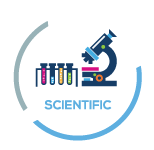Measures
Questionnaire. an ad hoc questionnaire to collect information on environmental exposure outdoor and indoor use, height and weight, diet, physical activity and other aspects of the lifestyle of children was used.
Biological sample. To collect the buccal cells, the children were asked to rinse their mouths twice with a saline solution (NaCl 0.45%) and saliva was collected in tubes containing 15 ml of normal saline (0.9% NaCl) in order to obtain the leukocytes to be analyzed by the Comet assay. Subsequently, the epithelial cells of the oral mucosa, to be tested with micronuclei test, were collected by brushing the inside of the cheek with a brush, which will then be immersed in tubes containing 15 ml of Buccal Cell Buffer (BCB) pH = 7, 0. This sampling method is simple and non-invasive and therefore acceptable by children from both parents.
The Comet assay and the MN test on the buccal cells should be performed on fresh material to prevent degradation.
Comet assay. The Comet assay on leukocytes of the mouth was performed in accordance with the method of Singh (A simple technique for quantitation of low levels of DNA damage in individual cells. Exper Cell Res 1988, 175:184-191).
Micronuclei test. The method was performed according to the method of Thomas (Buccal micronucleus cytome assay. Nat Protoc. 2009; 4 (6) :825-837).
Collection of environmental samples. In order to assess the quality of all the cities involved in the research, a high-volume sampler, was located near schools where children were recruited to collect the PM 0.5 on membranes made of glass fiber for 72 hours. All the membranes were sent to the Unit of Brescia for chemical (concentration of PAHs and nitroIPA) and in vitro mutagenesis analysis.
Ames test. On organic extracts of PM 0.5 the Ames test was performed according to the method of Maron and Ames (Revised methods for the Salmonella mutagenicity test. Mut Res 1983, 113: 173-215).
Comet assay and micronuclei assay in A549 cells. Aliquots of the extract organic PM 0.5 was sent to the University of Turin for Comet assay according to the method of Singh et al. (A simple technique for quantitation of low levels of DNA damage in individual cells. Exper Cell Res 1988, 175:184-191) and to the University of Perugia for the micronuclei assay according to the method of Fenech (The in vitro micronucleus technique. Mutation Research., 2000; 455:81-95) both on human respiratory cells (cell line A549)
Toxicity test in A549 cells and HFBE2. Meanwhile other aliquots of PM 0.5 were tested for toxicity tests on two different human cell lines (bronchial and alveolar) to assess proliferation, cell viability and the possible effects on intercellular communication.
Data recording of the chemical parameters. ARPA data were collected on the main parameters routinely measured air quality (CO, NO2, SO2, benzene, O3, PM 10, PM 2.5) related to the sampling periods.
Data management. A single database collectiong all data was created. Both files was protected by a password, known only to the researchers and kept in the documentation of the study.
Risk analysis and validation. The risk analysis for health impact assessment from exposure to pollution, using a model that quantitatively estimate the carcinogenic risk from exposure to polluted air using both standard parameters (PM 10, PM 2.5, NOx, and others) as well as those investigated in the research (IPA and nitroIPA) was coordinated by the University of Salento. The comparison between the estimates of the risk of carcinogenic effects produced by the model (value "expected") and the test results of DNA damage on buccal cells (value "observed") was used to assess the goodness of the model for the prediction of early biological effects in children.
Statistical analysis and construction of a global model for the risk assessment. The differences in the indicators of biological effect in children with higher and lower exposure to traditional air pollutants was carried out primarily through the tests, parametric and nonparametric, more commonly used for comparing distributions, averages and proportions. In addition, multivariate analysis was used to evaluate the association between effect indicators and environmental parameters.
The analysis of food questionnaires permitted to study a composite dietary pattern.
The role of interaction factors related to pollutants exposure and biological effects through stratified analyzes and statistical models was analyzed.
According to these data a global model for risk esctimation was created.
Biological sample. To collect the buccal cells, the children were asked to rinse their mouths twice with a saline solution (NaCl 0.45%) and saliva was collected in tubes containing 15 ml of normal saline (0.9% NaCl) in order to obtain the leukocytes to be analyzed by the Comet assay. Subsequently, the epithelial cells of the oral mucosa, to be tested with micronuclei test, were collected by brushing the inside of the cheek with a brush, which will then be immersed in tubes containing 15 ml of Buccal Cell Buffer (BCB) pH = 7, 0. This sampling method is simple and non-invasive and therefore acceptable by children from both parents.
The Comet assay and the MN test on the buccal cells should be performed on fresh material to prevent degradation.
Comet assay. The Comet assay on leukocytes of the mouth was performed in accordance with the method of Singh (A simple technique for quantitation of low levels of DNA damage in individual cells. Exper Cell Res 1988, 175:184-191).
Micronuclei test. The method was performed according to the method of Thomas (Buccal micronucleus cytome assay. Nat Protoc. 2009; 4 (6) :825-837).
Collection of environmental samples. In order to assess the quality of all the cities involved in the research, a high-volume sampler, was located near schools where children were recruited to collect the PM 0.5 on membranes made of glass fiber for 72 hours. All the membranes were sent to the Unit of Brescia for chemical (concentration of PAHs and nitroIPA) and in vitro mutagenesis analysis.
Ames test. On organic extracts of PM 0.5 the Ames test was performed according to the method of Maron and Ames (Revised methods for the Salmonella mutagenicity test. Mut Res 1983, 113: 173-215).
Comet assay and micronuclei assay in A549 cells. Aliquots of the extract organic PM 0.5 was sent to the University of Turin for Comet assay according to the method of Singh et al. (A simple technique for quantitation of low levels of DNA damage in individual cells. Exper Cell Res 1988, 175:184-191) and to the University of Perugia for the micronuclei assay according to the method of Fenech (The in vitro micronucleus technique. Mutation Research., 2000; 455:81-95) both on human respiratory cells (cell line A549)
Toxicity test in A549 cells and HFBE2. Meanwhile other aliquots of PM 0.5 were tested for toxicity tests on two different human cell lines (bronchial and alveolar) to assess proliferation, cell viability and the possible effects on intercellular communication.
Data recording of the chemical parameters. ARPA data were collected on the main parameters routinely measured air quality (CO, NO2, SO2, benzene, O3, PM 10, PM 2.5) related to the sampling periods.
Data management. A single database collectiong all data was created. Both files was protected by a password, known only to the researchers and kept in the documentation of the study.
Risk analysis and validation. The risk analysis for health impact assessment from exposure to pollution, using a model that quantitatively estimate the carcinogenic risk from exposure to polluted air using both standard parameters (PM 10, PM 2.5, NOx, and others) as well as those investigated in the research (IPA and nitroIPA) was coordinated by the University of Salento. The comparison between the estimates of the risk of carcinogenic effects produced by the model (value "expected") and the test results of DNA damage on buccal cells (value "observed") was used to assess the goodness of the model for the prediction of early biological effects in children.
Statistical analysis and construction of a global model for the risk assessment. The differences in the indicators of biological effect in children with higher and lower exposure to traditional air pollutants was carried out primarily through the tests, parametric and nonparametric, more commonly used for comparing distributions, averages and proportions. In addition, multivariate analysis was used to evaluate the association between effect indicators and environmental parameters.
The analysis of food questionnaires permitted to study a composite dietary pattern.
The role of interaction factors related to pollutants exposure and biological effects through stratified analyzes and statistical models was analyzed.
According to these data a global model for risk esctimation was created.
-
-
-
-
-
-
-
-
16/11/2016 - CONFERENCES
49° Congresso Nazionale Società Italiana di Igiene e Medicina Preventiva
Naples, 16-19 November 2016 -
-
-
21/09/2016 - CONFERENCES
XVI National Congress of Environmental Chemistry and Cultural Heritage
Lecce, 26-29 june 2016 -
21/09/2016 - CONFERENCES
28th annual conference International Society for Environmental Epidemiology
Rome, September 1 – 4th 2016 -
21/09/2016 - CONFERENCES
52nd European Congress of the European Societies of Toxicology
Seville, September 04-07, 2016. -
21/09/2016 - CONFERENCES
International Conference of Environmental and Occupational Health
21-23 june 2016. Porto -
-
-
19/10/2015 - CONFERENCES
8th European Public Health Conference
14 - 17 October 2015. MiCo, Milan, Italy -
13/10/2015 - CONFERENCES
48° Congresso Nazionale SItI 2015
Milano Congressi (MiCo), Milan, Italy 14–17 October 2015 -
07/10/2015 - CONFERENCES
17th International Conference on Environmental Pollution and Public Health
14-15 September 2015 -
-
-
-
27/11/2014 - CONFERENCES
Abstract South Italian Mapec Workshop
Lecce, Hotel Hilton Garden Inn, 27 November 2014 -





